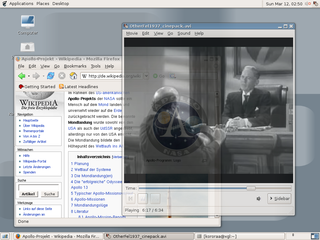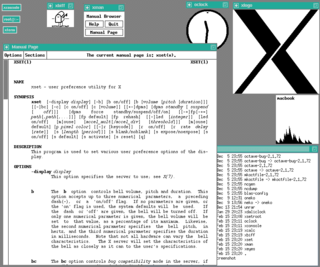
XFree86 is an implementation of the X Window System. It was originally written for Unix-like operating systems on IBM PC compatibles and was available for many other operating systems and platforms. It is free and open source software under the XFree86 License version 1.1. It was developed by the XFree86 Project, Inc. The lead developer was David Dawes. The last released version was 4.8.0, released December 2008. The last XFree86 CVS commit was made on May 18, 2009; the project was confirmed dormant in December 2011.
GLX is an extension to the X Window System core protocol providing an interface between OpenGL and the X Window System as well as extensions to OpenGL itself. It enables programs wishing to use OpenGL to do so within a window provided by the X Window System. GLX distinguishes two "states": indirect state and direct state.
Keith Packard is a software developer, best known for his work on the X Window System.
Mesa, also called Mesa3D and The Mesa 3D Graphics Library, is an open source software implementation of OpenGL, Vulkan, and other graphics API specifications. Mesa translates these specifications to vendor-specific graphics hardware drivers.

Xgl is an obsolete display server implementation supporting the X Window System protocol designed to take advantage of modern graphics cards via their OpenGL drivers, layered on top of OpenGL. It supports hardware acceleration of all X, OpenGL and XVideo applications and graphical effects by a compositing window manager such as Compiz or Beryl. The project was started by David Reveman of Novell and first released on January 2, 2006. It was removed from the X.org server in favor of AIGLX on June 12, 2008.

A free and open-source graphics device driver is a software stack which controls computer-graphics hardware and supports graphics-rendering application programming interfaces (APIs) and is released under a free and open-source software license. Graphics device drivers are written for specific hardware to work within a specific operating system kernel and to support a range of APIs used by applications to access the graphics hardware. They may also control output to the display if the display driver is part of the graphics hardware. Most free and open-source graphics device drivers are developed by the Mesa project. The driver is made up of a compiler, a rendering API, and software which manages access to the graphics hardware.
X-Video Motion Compensation (XvMC), is an extension of the X video extension (Xv) for the X Window System. The XvMC API allows video programs to offload portions of the video decoding process to the GPU video-hardware. In theory this process should also reduce bus bandwidth requirements. Currently, the supported portions to be offloaded by XvMC onto the GPU are motion compensation and inverse discrete cosine transform (iDCT) for MPEG-2 video. XvMC also supports offloading decoding of mo comp, iDCT, and VLD for not only MPEG-2 but also MPEG-4 ASP video on VIA Unichrome hardware.

nouveau is a free and open-source graphics device driver for Nvidia video cards and the Tegra family of SoCs written by independent software engineers, with minor help from Nvidia employees.
Unified Video Decoder (UVD), previously called Universal Video Decoder, is the name given to AMD's dedicated video decoding ASIC. There are multiple versions implementing a multitude of video codecs, such as H.264 and VC-1.
The Evergreen series is a family of GPUs developed by Advanced Micro Devices for its Radeon line under the ATI brand name. It was employed in Radeon HD 5000 graphics card series and competed directly with Nvidia's GeForce 400 Series.

AMD Radeon Software is a device driver and utility software package for Advanced Micro Devices's graphics cards and APUs. It is built using the Qt toolkit and runs on Microsoft Windows and Linux, 32- and 64-bit x86 processors.
The Socket FS1 is for notebooks using AMD APU processors codenamed Llano, Trinity and Richland.
AMD's Socket FT3 or BGA-769 targets mobile devices and was designed for APUs codenamed Kabini and Temash, Beema and Mullins.
The Socket FT1 or BGA413 is a CPU socket released in January 2011 from AMD for its APUs codenamed Desna, Ontario, Zacate and Hondo. The uber name is "Brazos".
The Socket FP2 or µBGA-827 is a CPU socket for notebooks that was released in May 2012 by AMD with its APU processors codenamed Trinity and Richland.
The Socket FP3 or µBGA906 is a CPU socket for laptops that was released in June 2014 by AMD with its mobility APU products codenamed Kaveri.

The Radeon R5/R7/R9 300 series is a series of Radeon graphics cards made by Advanced Micro Devices (AMD). All of the GPUs of the series are produced in 28 nm format and use the Graphics Core Next (GCN) micro-architecture.










